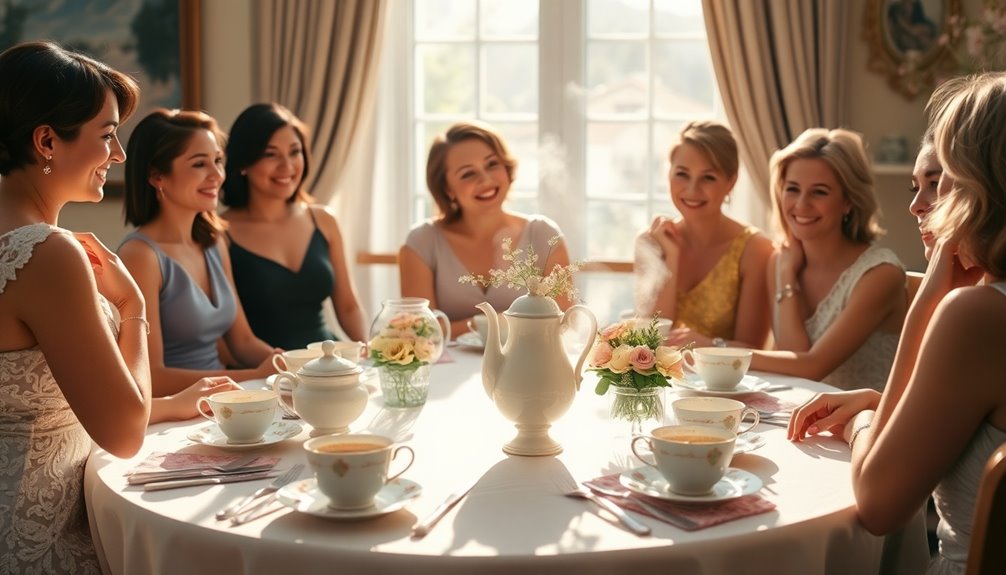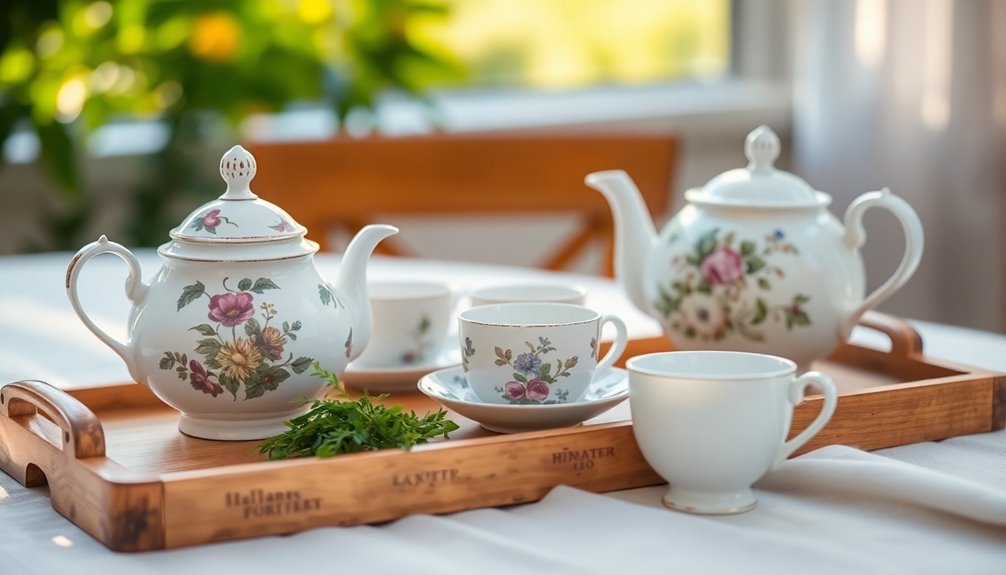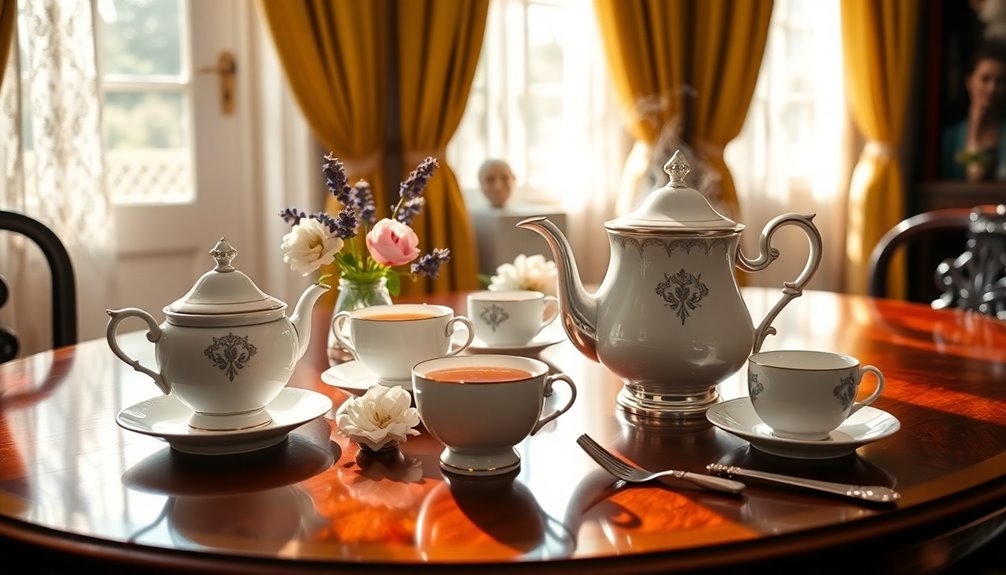Tea etiquette reflects a rich history that shapes traditions across cultures. It began in ancient China, emphasizing respect and hospitality. In the Victorian era, afternoon tea emerged as a fashionable social event, marking a shift where women could gather and engage in conversation. Specific rules for handling cups and adding milk illustrate social norms. As tea crosses cultural boundaries, unique ceremonies like Japan's Chanoyu and China's Gongfu tea expand these traditions globally. This blend creates meaningful communal experiences. There's much more to uncover about the fascinating connections that tea etiquette nurtures through time and culture.
Key Takeaways
- Formal tea etiquette originated in ancient China, emphasizing respect and hospitality during tea ceremonies.
- Afternoon tea became a fashionable Victorian social event, bridging lunch and dinner while highlighting refinement in dining customs.
- Tea rituals foster social connections, with proper cup handling reflecting societal norms and enhancing communal experiences.
- Cultural fusion is evident in various tea ceremonies, showcasing diverse traditions that emphasize harmony and appreciation across different cultures.
- Colonial impact on tea trade altered global dynamics, leading to the establishment of tea plantations and changing local economies through labor exploitation.
Introduction

Tea etiquette isn't just about sipping a warm beverage; it's a rich tapestry woven from centuries of tradition, culture, and social interaction.
Originating from formal tea ceremonies in ancient China, this practice emphasizes respect and hospitality. When you enjoy afternoon tea, you're participating in a tradition that the upper classes popularized during the Victorian era, particularly by the Duchess of Bedford.
As you navigate the nuances of tea drinking, you'll discover that etiquette extends beyond just the drink itself. It includes specific rules, like how to hold your teacup and the correct order for adding milk and sugar.
You'll notice that using porcelain cups not only elevates the experience but also reflects social customs that differentiate the upper classes from the middle class.
Victorian Tea Time Origins
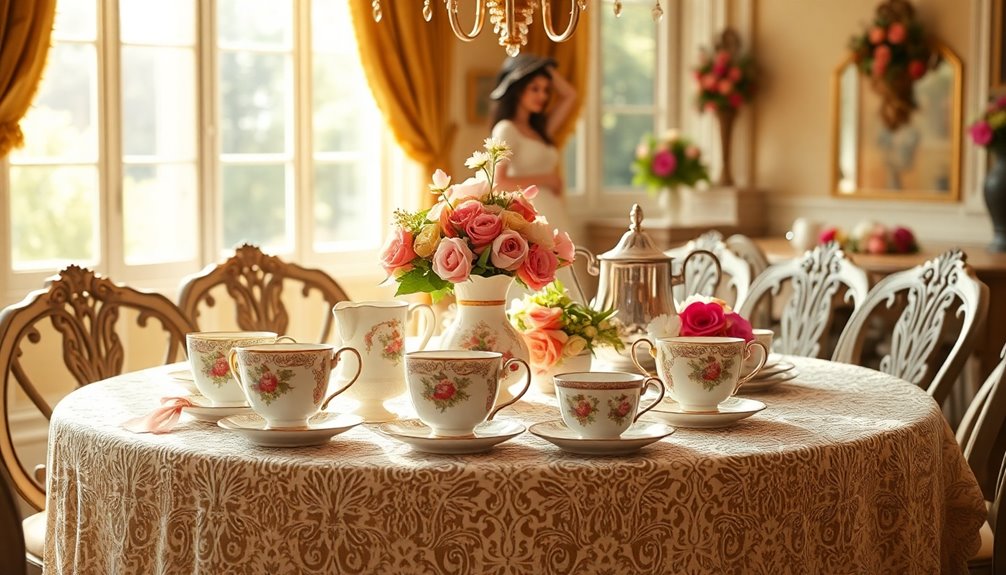
In the early 19th century, the Victorian era saw the birth of afternoon tea, a delightful tradition largely credited to Anna Maria Russell, the Duchess of Bedford. She introduced this practice to bridge the gap between lunch and dinner, offering light refreshments at the afternoon tea table.
Initially a custom among the upper classes, afternoon tea quickly evolved into a fashionable social event, featuring finger sandwiches, scones, pastries, and, of course, tea.
Victorian tea time became a symbol of social etiquette, reflecting the era's emphasis on refinement in dining customs. It provided a cultural space where women could gather, converse, and strengthen friendships, often without the presence of men. This marked a significant shift in gender dynamics, as it allowed women to assert their social presence in a structured environment.
As urbanization and industrialization progressed, afternoon tea transcended its upper-class origins, becoming commonplace among the middle class.
This tea tradition not only fostered social connections but also highlighted the evolving nature of society during the Victorian period, making a lasting impact on how tea is enjoyed today.
Tea's Role in Social Gatherings
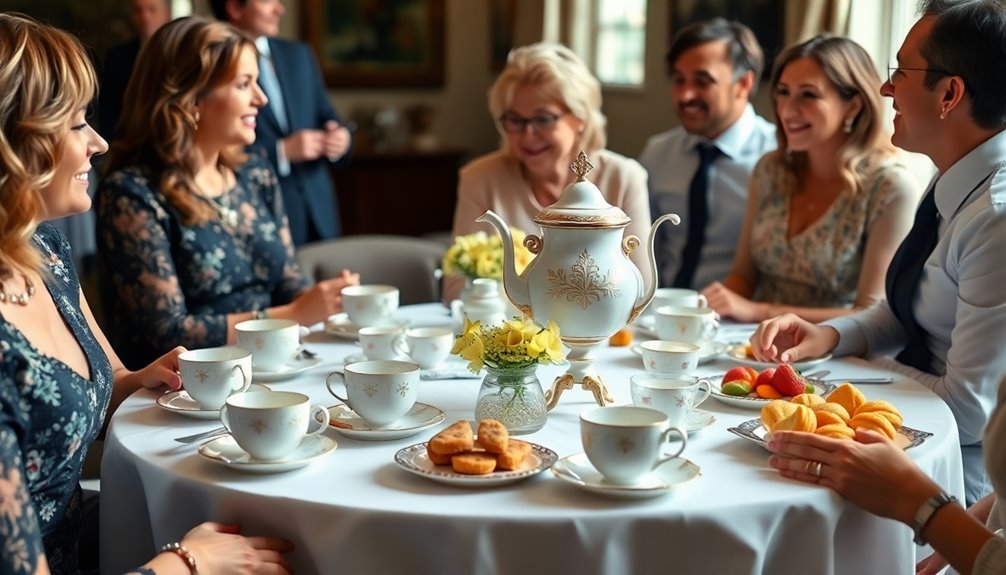
Throughout history, countless social gatherings have revolved around the ritual of tea, serving as a means to foster connections and engage in meaningful conversation. The afternoon tea tradition, first popularized by Anna Maria Russell, Duchess of Bedford, transformed tea drinking into a fashionable event among the upper classes. This ritual quickly became a staple for social gatherings, often involving you and your friends sharing light refreshments like finger sandwiches, scones, and pastries.
At these tea parties, the etiquette surrounding tea drinking was paramount. Proper cup handling and stirring techniques reflected the social norms of the time, reinforcing the importance of manners in formal settings. The gatherings weren't just about drinking tea; they emphasized a communal experience where conversation flowed as freely as the tea itself.
As Queen Victoria's ladies-in-waiting participated in this charming ritual, they helped solidify its role in society.
Today, afternoon tea remains a cherished tradition, with modern venues offering themed experiences and high-quality ingredients. This enduring practice highlights how tea continues to be a popular drink that brings people together, creating lasting memories and fostering connections.
Cultural Fusion Through Tea Ceremonies
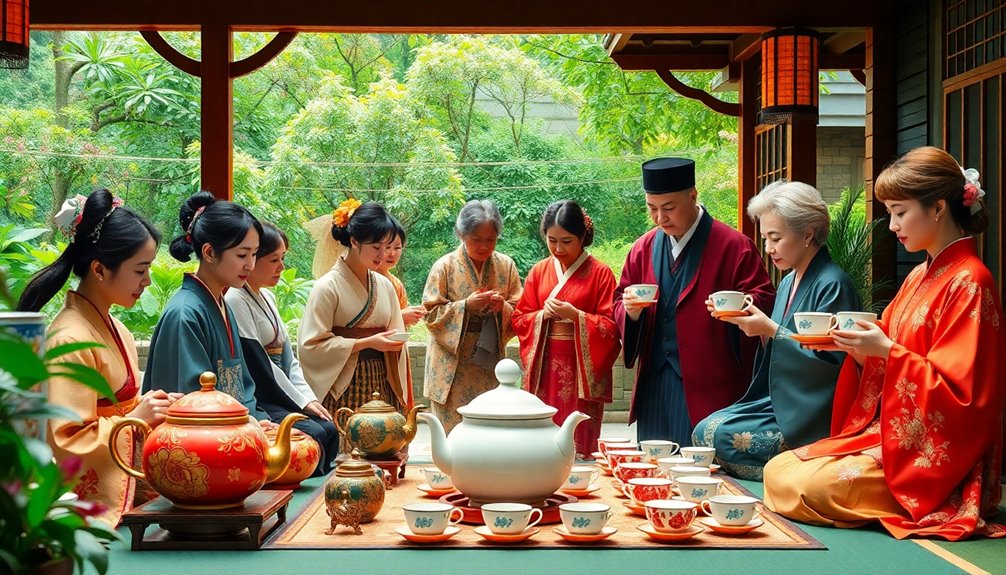
The communal experience of tea drinking has evolved across cultures, showcasing a rich tapestry of traditions and practices.
Tea ceremonies, like the Japanese Chanoyu, emphasize harmony and respect, revealing the cultural significance of tea beyond mere consumption. In China, the Gongfu tea ceremony highlights the careful preparation and appreciation of diverse tea types, transforming the act of drinking into a meaningful social ritual. The use of specific utensils like tea bowls and whisks adds to the authenticity and depth of the ceremony.
The British afternoon tea tradition, initiated by the Duchess of Bedford, reflects a fusion of customs where light refreshments and etiquette became central to social gatherings among the upper classes.
As globalization continues to influence our world, modern tea ceremonies often blend elements from various cultures, creating unique tea experiences that appeal to a broad audience.
Today's tea cafes showcase this cultural fusion, offering an array of tea types and serving methods that combine traditional elements with contemporary influences.
As you participate in these rituals, you'll notice how the etiquette and practices of tea drinking can vary widely, yet ultimately unite people in a shared appreciation of this ancient beverage. Incorporating elements of aromatherapy oils can enhance the overall experience, adding a sensory layer to the enjoyment of tea.
Embrace the diverse customs, and enjoy the rich history each cup of tea brings.
Colonial Exploitation of Tea Trade
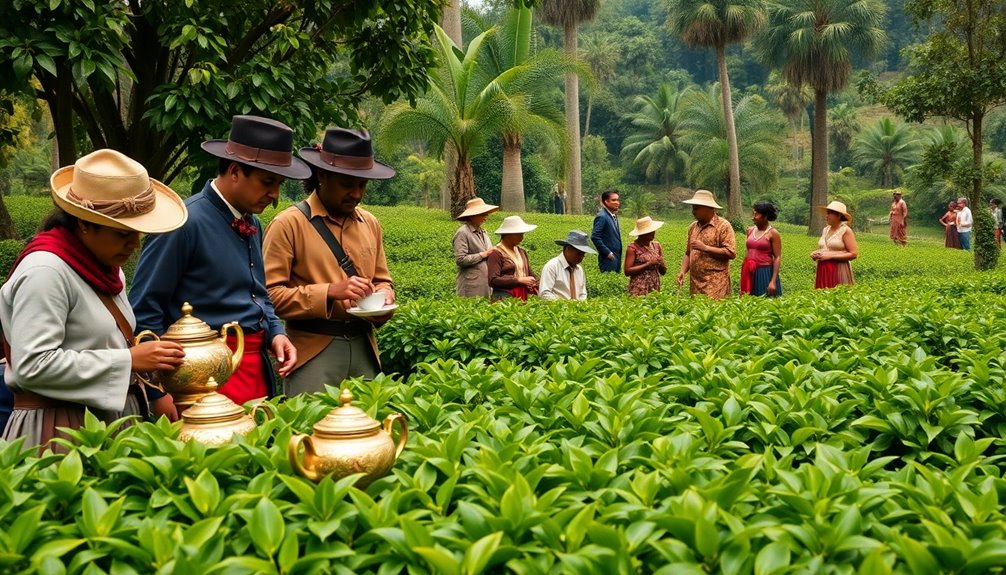
Colonial exploitation of the tea trade reshaped economies and cultures across the globe, leaving a lasting impact that's still felt today. The British East India Company began significant tea imports in 1664, establishing monopolistic control and enforcing high taxation on tea in England.
This demand for tea fueled the Opium Wars, causing economic and social upheaval in both China and Britain, as Britain sought to balance trade deficits.
To reduce dependence on Chinese tea, the British established tea plantations in India, particularly in Assam and Darjeeling. While this initiative transformed local economies, it often led to labor exploitation and political unrest, exemplified by events like the Boston Tea Party.
The introduction of tea cultivation in British colonies not only changed trade dynamics but also created a thriving black market for tea.
Practical Applications
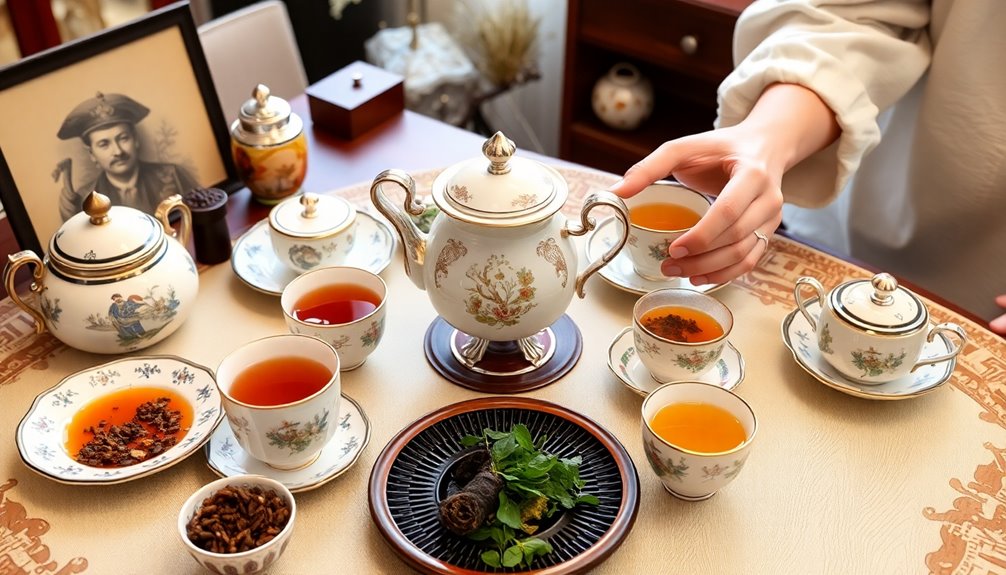
Understanding tea etiquette is as important as recognizing the historical context of the tea trade. When you enjoy afternoon tea, remember that proper etiquette enhances the overall tea experience.
Start by placing your napkin on your lap and holding your porcelain teacup by the handle, with your fingers positioned at the 12 o'clock and 6 o'clock positions for balance. Stir gently at the 6 o'clock position, avoiding clinking sounds, and always place your spoon on the saucer after use.
When it comes to milk, pour your tea first before adding milk into the cup; this preserves the flavor and temperature.
As for scones, break them apart with your fingers instead of using a knife. The debate between clotted cream and jam first is a matter of regional pride—choose jam first for a Cornish approach or cream first for a Devonshire tradition.
During your tea, take small bites and sip your tea without washing down food. This refined manner of dining not only respects the tradition but also creates a delightful atmosphere, allowing you to savor each moment of your silver tea experience.
Conclusion
In conclusion, understanding the history of tea etiquette enriches your appreciation for this beloved beverage. Whether you're hosting a Victorian-style tea party or enjoying a simple cup with friends, the traditions surrounding tea can enhance your social experiences. By recognizing tea's cultural significance and the impact of its colonial past, you can celebrate its legacy while fostering connections in your own gatherings. So, next time you sip your tea, remember the rich history that shapes your moment.



